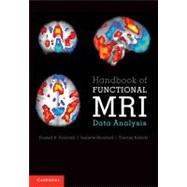
What is included with this book?
| Preface | p. ix |
| Introduction | p. 1 |
| A brief overview of fMRI | p. 1 |
| The emergence of cognitive neuroscience | p. 3 |
| A brief history of fMRI analysis | p. 4 |
| Major components of fMRI analysis | p. 7 |
| Software packages for fMRI analysis | p. 7 |
| Choosing a software package | p. 10 |
| Overview of processing streams | p. 10 |
| Prerequisites for fMRI analysis | p. 10 |
| Image processing basics | p. 13 |
| What is an image? | p. 13 |
| Coordinate systems | p. 15 |
| Spatial transformations | p. 17 |
| Filtering and Fourier analysis | p. 31 |
| Preprocessing fMRI data | p. 34 |
| Introduction | p. 34 |
| An overview of fMRI preprocessing | p. 34 |
| Quality control techniques | p. 34 |
| Distortion correction | p. 38 |
| Slice timing correction | p. 41 |
| Motion correction | p. 43 |
| Spatial smoothing | p. 50 |
| Spatial normalization | p. 53 |
| Introduction | p. 53 |
| Anatomical variability | p. 53 |
| Coordinate spaces for neuroimaging | p. 54 |
| Atlases and templates | p. 55 |
| Preprocessing of anatomical images | p. 56 |
| Processing streams for fMRI normalization | p. 58 |
| Spatial normalization methods | p. 60 |
| Surface-based methods | p. 62 |
| Choosing a spatial normalization method | p. 63 |
| Quality control for spatial normalization | p. 65 |
| Troubleshooting normalization problems | p. 66 |
| Normalizing data from special populations | p. 66 |
| Statistical modeling: Single subject analysis | p. 70 |
| The BOLD signal | p. 70 |
| The BOLD noise | p. 86 |
| Study design and modeling strategies | p. 92 |
| Statistical modeling: Group analysis | p. 100 |
| The mixed effects model | p. 100 |
| Mean centering continuous covariates | p. 105 |
| Statistical inference on images | p. 110 |
| Basics of statistical inference | p. 110 |
| Features of interest in images | p. 112 |
| The multiple testing problem and solutions | p. 116 |
| Combining inferences: masking and conjunctions | p. 123 |
| Use of region of interest masks | p. 126 |
| Computing statistical power | p. 126 |
| Modeling brain connectivity | p. 130 |
| Introduction | p. 130 |
| Functional connectivity | p. 131 |
| Effective connectivity | p. 144 |
| Network analysis and graph theory | p. 155 |
| Multivoxel pattern analysis and machine learning | p. 160 |
| Introduction to pattern classification | p. 160 |
| Applying classifiers to fMRI data | p. 163 |
| Data extraction | p. 163 |
| Feature selection | p. 164 |
| Training and testing the classifier | p. 165 |
| Characterizing the classifier | p. 171 |
| Visualizing, localizing, and reporting fMRI data | p. 173 |
| Visualizing activation data | p. 173 |
| Localizing activation | p. 176 |
| Localizing and reporting activation | p. 179 |
| Region of interest analysis | p. 183 |
| Review of the General Linear Model | p. 191 |
| Estimating GLM parameters | p. 191 |
| Hypothesis testing | p. 194 |
| Correlation and heterogeneous variances | p. 195 |
| Why "general" linear model? | p. 197 |
| Data organization and management | p. 201 |
| Computing for fMRI analysis | p. 201 |
| Data organization | p. 202 |
| Project management | p. 204 |
| Scripting for data analysis | p. 205 |
| Image formats | p. 208 |
| Data storage | p. 208 |
| File formats | p. 209 |
| Bibliography | p. 211 |
| Index | p. 225 |
| Table of Contents provided by Ingram. All Rights Reserved. |
The New copy of this book will include any supplemental materials advertised. Please check the title of the book to determine if it should include any access cards, study guides, lab manuals, CDs, etc.
The Used, Rental and eBook copies of this book are not guaranteed to include any supplemental materials. Typically, only the book itself is included. This is true even if the title states it includes any access cards, study guides, lab manuals, CDs, etc.